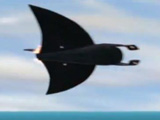|
|
TODAY.AZ / Weird / Interesting
Pentagon to develop a "submarine-aeroplane" hybrid
08 July 2010 [16:10] - TODAY.AZ
Pentagon researchers are attempting to develop a military vehicle which can travel underwater like a submarine before bursting out of the waves and flying like an aeroplane.
 The Defense Advanced Research Projects Agency (DARPA), the US military science and technology department, has set about creating an aircraft that can fly low over the water until near its target before disappearing under the sea to avoid detection.
The Defense Advanced Research Projects Agency (DARPA), the US military science and technology department, has set about creating an aircraft that can fly low over the water until near its target before disappearing under the sea to avoid detection.It would then creep closer in submarine form before attacking its target, probably a ship or coastal installation, and fly home.
New Scientist reports that the project, which has been in development since 2008, has reached design proposal stage, and several outside developers have submitted designs. DARPA could start allocating funding to developers in as little as a year.
While the principles of hydrodynamic and aerodynamic flight are similar, the technological challenges are profound. Aircraft need to be as light as possible, so that they can use a minimum of power to get airborne, while submarines need to be dense and strong to withstand water pressure. Heavier-than-air aircraft get their lift from airflow over their wings - submarines simply pump water in and out to change their buoyancy.
One method of getting around the latter problem is to design a submarine that is lighter than water, but - like an upside-down aeroplane - uses lift generated by its wings to force it away from the surface. Then, after surfacing, the wings' "angle of attack" would be changed to generate upwards lift instead, allowing it to fly.
Graham Hawkes, a submarine designer, believes that modern lightweight carbon fibre composites could be used to build a craft that is both strong enough and light enough to fly above and below the water. He has already designed and built a submersible craft called the "Super Falcon" which uses stubby wings to "fly" down to 300 metres. He says that if it were given jet engines and larger wings, it could fly at up to 900kph (560mph) in the air, while still being capable of underwater travel at around 18kph (11mph). At these speeds, the behaviour of water and air over the control surfaces is similar. "Think about it as flying under water," says Mr Hawkes. "It can be done. It just needs a lot of work."
One problem could be overcome in a dramatic fashion - in order to get the wings to start generating downward lift, the craft would have to get underwater; but a lighter-than-water vessel would struggle to do so. Mr Hawkes suggests copying birds: "You might have to put the nose down and literally dive, smack, into the water. It would certainly be spectacular."
There are a variety of other design problems to overcome. Ordinary batteries capable of giving the craft a 44km (28 mile) range - as specified by DARPA - would weigh more than the rest of the vessel, but running it on ordinary fuel would require a supply of air, meaning a snorkel and a maximum depth of just a few meters.
Also, jet engines - which run at several hundred degrees celsius - would most likely explode from the sudden change in temperature if they were rapidly submerged after airborne use, but piston engines would not survive being immersed in water. Jim McKenna, an engineer at the UK Civil Aviation Authority, says: "You can't let cold seawater get at a hot engine because the thermal shock will blow it apart." The Pentagon's dream of a flying submarine is still some way away yet.
/Telegraph.co.uk/
URL: http://www.today.az/news/interesting/70692.html
 Print version
Print version
Views: 3276
Connect with us. Get latest news and updates.
See Also
- 19 February 2025 [22:20]
Visa and Mastercard can return to Russia, but with restrictions - 05 February 2025 [19:41]
Japan plans to negotiate with Trump to increase LNG imports from United States - 23 January 2025 [23:20]
Dubai once again named cleanest city in the world - 06 December 2024 [22:20]
Are scented candles harmful to health? - 23 November 2024 [14:11]
Magnitude 4.5 earthquake hits Azerbaijan's Lachin - 20 November 2024 [23:30]
Launch vehicle with prototype of Starship made its sixth test flight - 27 October 2024 [09:00]
Fuel prices expected to rise in Sweden - 24 October 2024 [19:14]
Turkiye strikes terror targets in Iraq and Syria - 23 October 2024 [23:46]
Kazakhstan supplied almost entire volume of oil planned for 2024 to Germany in 9 months - 23 October 2024 [22:17]
Taiwan reported passage of Chinese Navy aircraft carrier near island
Most Popular
 Pakistan’s expanding defence partnerships put Azerbaijan in strategic spotlight
Pakistan’s expanding defence partnerships put Azerbaijan in strategic spotlight
 US Embassy commemorates anniversary of Azal plane crash
US Embassy commemorates anniversary of Azal plane crash
 Baku ask world uncomfortable questions. We are waiting for response
Baku ask world uncomfortable questions. We are waiting for response
 President Ilham Aliyev makes post on anniversary of AZAL plane crash
President Ilham Aliyev makes post on anniversary of AZAL plane crash
 Student Loan Fund announces partial forgiveness for 2,360 graduates
Student Loan Fund announces partial forgiveness for 2,360 graduates
 Xiaomi introduces the 17 Ultra smartphone
Xiaomi introduces the 17 Ultra smartphone
 VP Y?lmaz highlights economic, security, climate agenda amid regional cooperation move
VP Y?lmaz highlights economic, security, climate agenda amid regional cooperation move
